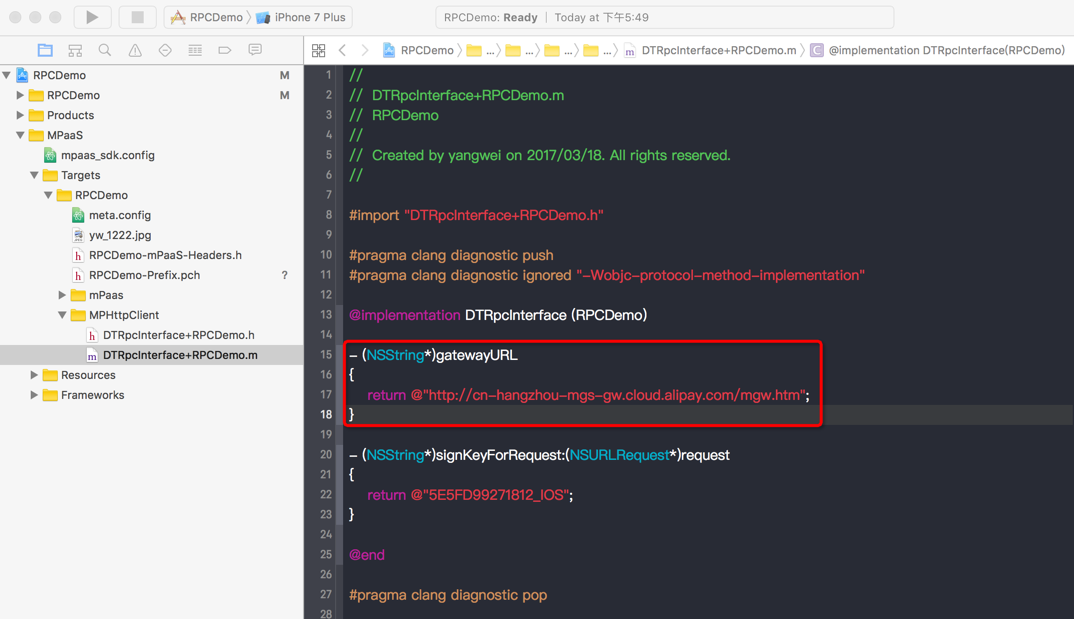RPC-related modules are APMobileNetwork.framework and MPMglsAdapter. We recommend that you use the APIs in MPMglsAdapter.
This topic describes how to use the mobile gateway SDK by performing the following steps:
Initialize the gateway service
Call the following method to initialize the gateway service:
[MPRpcInterface initRpc];Precautions for upgrading an earlier version
After the 10.1.32 version, you no longer need to add Category files of the DTRpcInterface class. The middle layer will implement packaging to read from the meta.config. After the version is upgraded, check whether the configuration of the old version exists in the project. If yes, remove it. Below is the Category file for the DTRpcInterface classes that should be removed for the new version.

Generate RPC code
After the app is connected to the background service in the mobile gateway console, you can download the RPC code of the client. For more information, see Generate code.
The structure of the downloaded RPC code is as follows:

Where:
RPCDemoCloudpay_accountClientto the RPC configuration.RPCDemoAuthLoginPostReqthe request model.RPCDemoLoginResultis the response model.
Send Request
RPC requests must be called in a sub-thread. You can use the sub-thread call interface encapsulated by the MPRpcInterface in the middle layer. The callback method is the main thread by default. The sample code is as follows:
- (void)sendRpc
{
__block RPCDemoLoginResult *result = nil;
[MPRpcInterface callAsyncBlock:^{
@try
{
RPCDemoLoginRequest *req = [[RPCDemoLoginRequest alloc] init];
req.loginId = @"alipayAdmin";
req.loginPassword = @"123456";
RPCDemoAuthLoginPostReq *loginPostReq = [[RPCDemoAuthLoginPostReq alloc] init];
loginPostReq._requestBody = req;
RPCDemoCloudpay_accountClient *service = [[RPCDemoCloudpay_accountClient alloc] init];
result = [service authLoginPost:loginPostReq];
}
@catch (NSException *exception) {
NSLog(@"%@", exception);
NSError *error = [userInfo objectForKey:@"kDTRpcErrorCauseError"]; // Obtain the exception details.
NSInteger code=error.code; // Obtain the error code of the exception details.
}
} completion:^{
NSString *str = @"";
if (result && result.success) {
str = @"Logon succeeded";
} else {
str = @"Logon failed";
}
UIAlertView *alert = [[UIAlertView alloc] initWithTitle:str message:nil delegate:nil
cancelButtonTitle:nil otherButtonTitles:@"ok", nil];
[alert show];
}];
}To use the try catch to catch exceptions, when the gateway will be thrown, according to the Gateway result code description query reason.
Request custom configurations
The RPC request method description DTRpcMethod records the RPC request method name, parameters, and return type.
If you do not need to sign the request, you can set the
DTRpcMethodsignCheckattribute to NO.-(MPDemoUserInfo *) dataPostSetTimeout:(MPDemoPostPostReq *)requestParam { DTRpcMethod *method = [[DTRpcMethod alloc] init]; method.operationType = @"com.antcloud.request.post"; method.checkLogin = NO ; method.signCheck = NO ; method.returnType = @"@\"MPDemoUserInfo\""; return [[DTRpcClient defaultClient] executeMethod:method params:@[ ]]; }If you need to set the timeout period, you can configure the
DTRpcMethodtimeoutIntervalproperties.-(MPDemoUserInfo *) dataPostSetTimeout:(MPDemoPostPostReq *)requestParam { DTRpcMethod *method = [[DTRpcMethod alloc] init]; method.operationType = @"com.antcloud.request.post"; method.checkLogin = NO ; method.signCheck = YES ; method.timeoutInterval = 1; // This timeout period is the time when the client receives the response from the gateway. The timeout period configured by the server is the time when the backend business system returns the response. The default value is 20s. If the setting is less than 1, it is invalid. method.returnType = @"@\"MPDemoUserInfo\""; return [[DTRpcClient defaultClient] executeMethod:method params:@[ ]]; }If you need to add headers to all APIs, you can use the following extension method.
DTRpcClient-(MPDemoUserInfo *) dataPostAddHeader:(MPDemoPostPostReq *)requestParam { DTRpcMethod *method = [[DTRpcMethod alloc] init]; method.operationType = @"com.antcloud.request.postAddHeader"; method.checkLogin = NO ; method.signCheck = YES ; method.returnType = @"@\"MPDemoUserInfo\""; // Add a header to the API. NSDictionary *customHeader = @{@"testKey": @"testValue"}; return [[DTRpcClient defaultClient] executeMethod:method params:@[ ] requestHeaderField:customHeader responseHeaderFields:nil]; }If you want to add headers to all APIs, use interceptors. For more information, see Use interceptors. For more information, see Sample code.
sessionthe property of thecheckLoginis used for verification, which needs to be completed in the gateway console. The default value is NO.
Custom RPC Interceptor
Based on business requirements, you may need to perform logic processing before the RPC is sent or after the RPC is processed. The RPC module provides an interceptor mechanism to handle such requirements.
Custom interceptor
Create interceptors and implement protocol -<DTRpcInterceptor> methods to process RPC requests before and after operations.
@interface HXRpcInterceptor : NSObject<DTRpcInterceptor>
@end
@implementation HXRpcInterceptor
- (DTRpcOperation *)beforeRpcOperation:(DTRpcOperation *)operation{
// TODO
return operation;
}
- (DTRpcOperation *)afterRpcOperation:(DTRpcOperation *)operation{
// TODO
return operation;
}
@endRegister an interceptor
You can call the extension interface of the middle layer to register custom subinterceptors in the interceptor container.
HXRpcInterceptor *mpTestIntercaptor = [[HXRpcInterceptor alloc] init]; // Custom subinterceptor
[MPRpcInterface addRpcInterceptor:mpTestIntercaptor];Data encryption
RPC provides various data encryption configuration features. For more information, see Data encryption.
Data signature (supported in 10.2.3)
The 10.2.3 baseline RPC provides a variety of data signature configuration features. 10.2.3 The baseline upgraded the wireless bodyguard SDK to support the national secret signature. After the upgrade, the wireless bodyguard picture needs to be replaced with V6 version to use this baseline.
The 10.1.68 baseline defaults to the V5 version. Follow these steps to use the plug-in to generate a V6 image and replace the original yw_1222.jpg wireless bodyguard image.
Install the mPaaS command-line tool. The command-line tool is included in the plug-in installation. You can set N by removing the Xcode signature.
Use the following command line to generate a new wireless bodyguard image.
mpaas inst sgimage -c /path/to/Ant-mpaas-0D4F511111111-default-IOS.config -V 6 -t 1 -o /path/to/output --app-secret sssssdderrff --verboseNoteReplace the config file directory, target file directory, and appsecret parameters with actual values.
If you want the wireless bodyguard to support the national secret function, please follow the following code to configure the category code to set the signature algorithm, the default configuration is not MPAASRPCSignTypeDefault, the signature algorithm is MD5.
Optional values of the signature algorithm are as follows:
MD5: MPAASRPCSignTypeDefault (default)
SHA256: MPAASRPCSignTypeSHA256
HMACSHA256: MPAASRPCSignTypeHMACSHA256
SM3: MPAASRPCSignTypeSM3
Sample code:
#import <APMobileNetwork/DTRpcInterface.h> @interface DTRpcInterface (mPaaSDemo) @end @implementation DTRpcInterface (mPaaSDemo) - (MPAASRPCSignType)customRPCSignType { return MPAASRPCSignTypeSM3; } @end